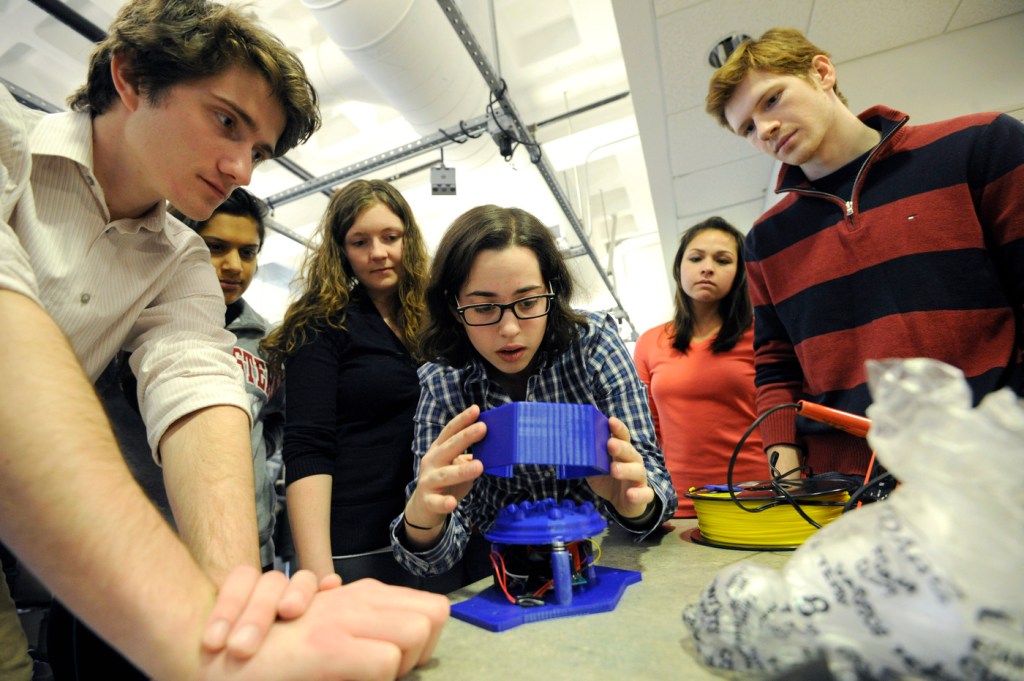Students spend spring break in Ecuador assisting children with disabilities

A group of Northeastern engineering and physical therapy students have spent months developing four devices designed to help children with disabilities at an orphanage in Ecuador. On Sunday, 15 students and their professor traveled to the South American country to spend their spring break working with these children and training clinicians on how to use these devices.
The effort is an interdisciplinary collaboration between associate professors Lorna Hayward and Waleed Meleis and their students in the departments of physical therapy and electrical and computer engineering. Hayward, who teaches a yearlong capstone course in physical therapy, partnered with Meleis, who advises the Enabling Engineering student organization, which is focused on applying engineering technologies to build low-cost devices that improve the lives of the elderly and people with disabilities. Meleis also teaches an Enabling Engineering course.
“Our goal is to help people in need and make the use of these devices as sustainable as possible,” said Hayward, who took her first cohort of students to the orphanage nine years ago.
Last year Hayward and her students brought two projects to Ecuador—a so-called communication button and an iPad touchscreen guard. This year, they’ve updated both of those projects and added two new ones. Here’s a closer look at all four devices:
1) Sensory cube
Clinicians at the orphanage requested a device that would enhance the sensory experience of children at the center, specifically for 3-year-old twins with cerebral palsy and limited vision. In response, the Northeastern team created two cubes, which measure 18 inches on all sides. Both feature activities on the various sides that the twins could use to engage their auditory and vestibular systems as well as their tactile and visual senses while allowing them to interact with other children. The cube focusing on hypertonia is designed to help the children using calming music and soothing tactile objects. The cube focusing on hypotonia features exciting music and sounds as well as different toys meant to encourage the children to use their cores for balance and for interacting with the different objects. (By students Tessa Fielding, Austin Goldenberg, Andrew Horowitz, Christina Policastro, Erik Ryde, Madison Schultz, Justine Steinberger, and Mara Wallisch)

Photo by Matthew Modoono/Northeastern University
2) Positioning pads
Students designed customized, adjustable, and durable pads to better position children in wheelchairs. The pads, which are made of canvas fabric and Saran wrapped foam on the inside, can be used in a variety of ways. For instance, they can be used to support the pelvis to improve their sitting position or placed behind their heel to reduce the pressure of their feet against the wheelchair. (By students Lucas Barton, Julian Costas, Emily Hagen, and Sarah Saffee)

Photo by Matthew Modoono/Northeastern University
3) Communication button
This project is designed for a 4-year-old child with autism who is nonverbal and partially blind and needed an effective way to communicate with his caretakers. Students developed a system that would allow him to express basic needs. They used 3-D printing to develop the casing and designed custom circuitry that stores and plays audio recordings. The communication button, which runs on a 9-volt battery and is modeled after the Staples Easy button, is mounted on the wall. Instructors record a word or phrase, and the child can press the button to play a command such as “Outside” or “I have to use the bathroom.” (By students Sam Bell, Marina Eaves, Pooja Jhaveri, Kyle Jones, and Tom Winsor)

Photo by Matthew Modoono/Northeastern University
4) Touchscreen guard
Hayward and Meleis explained that children with developmental delays who have limited ability to communicate can use iPads with communication applications to speak, yet children with certain disabilities often lack the fine motor skills to press the correct buttons on the screen of tablets. Clinicians at the orphanage requested tablet covers that would make it easier for the user—in this case, three children with cerebral palsy who are non-verbal—to only select the items on the screen being used for a lesson. The students created touchscreen guards featuring a 3-D printed base and a laser-cut plastic cover. The covers each have a different number of holes, to help guide users’ button pushing depending on which lesson in the communication app is being used. (By students Sam Bell, Marina Eaves, and Tom Winsor)

Photo by Matthew Modoono/Northeastern University





